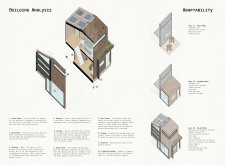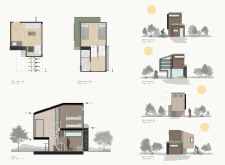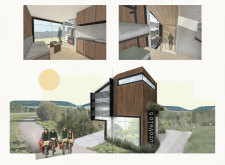5 key facts about this project
The European Velo Stops project focuses on providing well-designed resting places for travelers along the EuroVelo 6 route. Set against varied landscapes, these cabins serve as both functional stops and markers for navigation. The design centers around a stone wall, which not only gives the structure stability but also connects it to the local surroundings. The project emphasizes usability, environmental responsibility, and adaptability in meeting the needs of different users.
Structural Elements
A central feature of the design is the stone wall, which acts as both a foundation and a guiding marker for travelers. This wall integrates into the landscape and helps create inviting spaces for rest. The flexible design allows for various configurations, from simple stops that provide information to more developed cabins that offer extensive resting areas. This versatility enhances the experience for cyclists and hikers alike.
Sustainability Features
The focus on sustainability is evident throughout the design. Each cabin is equipped with solar panels to generate energy, reducing the need for traditional power sources. The large windows on the east side permit abundant natural light to fill the interior, creating a bright atmosphere while improving energy efficiency. This design choice also establishes a strong connection between the inside spaces and the natural environment outside, allowing for a pleasant user experience.
Local Context and Materiality
The project values local resources by using materials sourced from the surrounding area. This practice supports regional craftsmanship and ensures that each cabin reflects its own unique context. By considering local architecture, the cabins maintain their own distinct styles while contributing to the overall network along the EuroVelo 6 route. This attention to materiality promotes a sense of place and belonging.
User Experience and Community Interaction
Cabins are designed to foster interactions among users, creating a welcoming atmosphere for those traveling the route. Features like logbooks allow visitors to share stories, enhancing community spirit. These elements encourage a sense of connection, making it more than just a stopover. By focusing on user experience, the design aims to enrich the journey for everyone passing through.
Sunlight filters through large windows, creating patterns on the interior walls, highlighting simple yet functional spaces and drawing attention to the relationship between the cabin and its surroundings. This careful design consideration brings the beauty of the landscape into the everyday experience of travelers.





















































